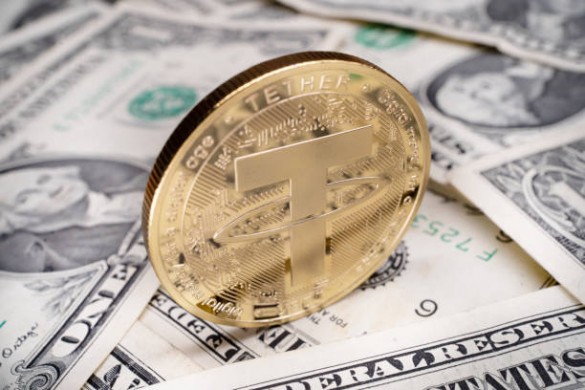Stablecoins, like Tether (USDT), are digital currencies pegged to traditional currencies like the US dollar. They’re gaining popularity because they offer a stable value and can be used for 24/7 transactions, serving as a reliable store of value and a way to exchange money easily. This is especially important in places with economic instability. Tether is the biggest player in this market, commanding over 75% of the stablecoin market. While there have been concerns about its transparency and reserves, recent statements from Cantor Fitzgerald’s CEO have helped ease some worries. However, due to its massive influence, it’s important to closely examine Tether’s operations and reserves.

USDT Soars: Stablecoin Supply Shatters Records
While the spotlight shines on the launch of spot Bitcoin ETFs, Tether quietly achieves a remarkable milestone. Its supply has soared to over $95 billion, marking a substantial 35% increase from last year. Notably, Ethereum and Tron host the majority of Tether’s supply, with $44 billion and $50.8 billion, respectively. Contrastingly, Tether’s issuance on Omni, once dominant, now comprises only 1% due to the network’s waning support. Tether’s adaptability is evident as it expands onto emerging layer-1 networks like Solana and Avalanche, broadening its utility across diverse on-chain ecosystems.
The Evolving Landscape of USDT
Recent events, including the Silicon Valley Bank collapse and the Operation Choke Point 2.0 fallout, might have spurred the rise of offshore stablecoins. This surge is driven by several factors. Notably, USDT (ETH) has gained traction in smart contracts, a realm once dominated by USDC. Market confidence in USDC waned after the SVB crisis, boosting USDT’s use in smart contracts. Since March 2023, USDT’s presence in this sector has grown from $4 billion to nearly $6.9 billion. This shift reflects USDT’s increasing popularity in decentralized finance (DeFi) applications, as highlighted in our “DeFi Balance Sheets” report section. USDT has surpassed USDC in leading money markets like Aave v2 and Compound, solidifying its role in the DeFi landscape.
USDT’s growing influence in DeFi, observed in lending platforms and exchanges, underscores its vital role in enabling trustless dollar transactions, facilitating broader and more efficient access to financial services.
Tether’s use in smart contracts has grown significantly, with a majority held by externally owned accounts (EOAs), which are controlled by private keys, similar to individual user accounts. The supply of Tether (ETH) in EOAs now stands at $37 billion, representing 84% of the total supply of Ethereum. These trends indicate the increasing acceptance of digital dollars, not just as a store of value or protection against price fluctuations, but also for their practical use in transactions such as trading or payments.

USDT’s Usage Pattern
Tether, the largest and most widely used stablecoin, has experienced significant usage. This month alone, on-chain transfers involving unique USDT addresses on Ethereum surpassed $5 billion, while on the Tron network, they exceeded $11 billion. Since its inception in 2014, Tether has facilitated over $13 trillion in transfers, highlighting its increasing adoption. This widespread use is particularly prominent in emerging markets across Africa, Latin America, South Asia, and beyond. In these regions, Tether often serves as a substitute for the U.S. dollar, providing a means to safeguard savings, pursue economic stability, and access banking infrastructure. This facilitates peer-to-peer transactions for various needs.
Examining typical Tether transactions sheds light on usage patterns and demographics served. Data shows that, on average, USDT transfers are smaller compared to USDC, which averages around $75,000 per transfer. This aligns with USDC’s role in larger-scale transactions and DeFi applications. On Ethereum, USDT transfers average $35,000, reflecting significant DeFi involvement due to higher transaction fees. Conversely, on Tron, with minimal fees, USDT transfers average $7,000, making it ideal for daily payments and remittances. These trends highlight diverse user preferences and the influence of underlying networks.
USDT, alongside other stablecoins, serves as a crucial quote asset, enabling the seamless trading of digital assets on exchanges. Amidst the recent surge in digital asset markets preceding the launch of spot Bitcoin ETFs, USDT has facilitated over $25 billion in reliable spot volumes, surpassing previous peaks in November 2022 and March 2023. Tether maintains a dominant position in this realm, accounting for over 85% of stablecoin-denominated trading volume.
What’s on the Horizon?
Tether’s remarkable rise underscores its practical value, particularly in unstable economies where access to a reliable currency is scarce. Despite concerns regarding centralization and transparency, its diverse benefits remain significant. Serving as a gateway to wider digital asset adoption, Tether has propelled the entire stablecoin market forward. While it currently dominates, its future amidst a changing landscape is uncertain. Circle’s public listing and the emergence of crypto-collateralized stablecoins add intrigue to this evolving ecosystem.
Learn from market wizards: Books to take your trading to the next level.


 Hot Features
Hot Features












